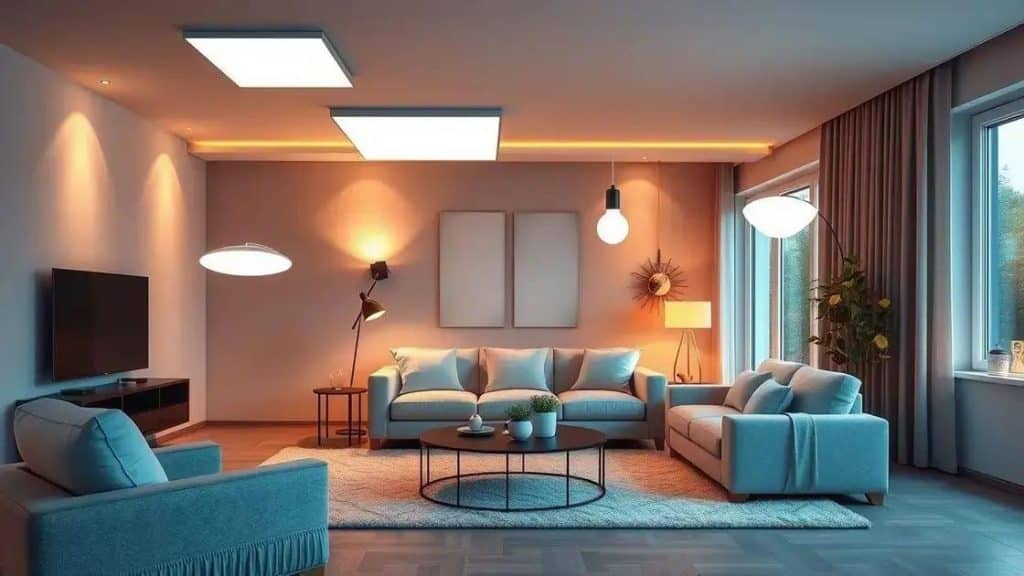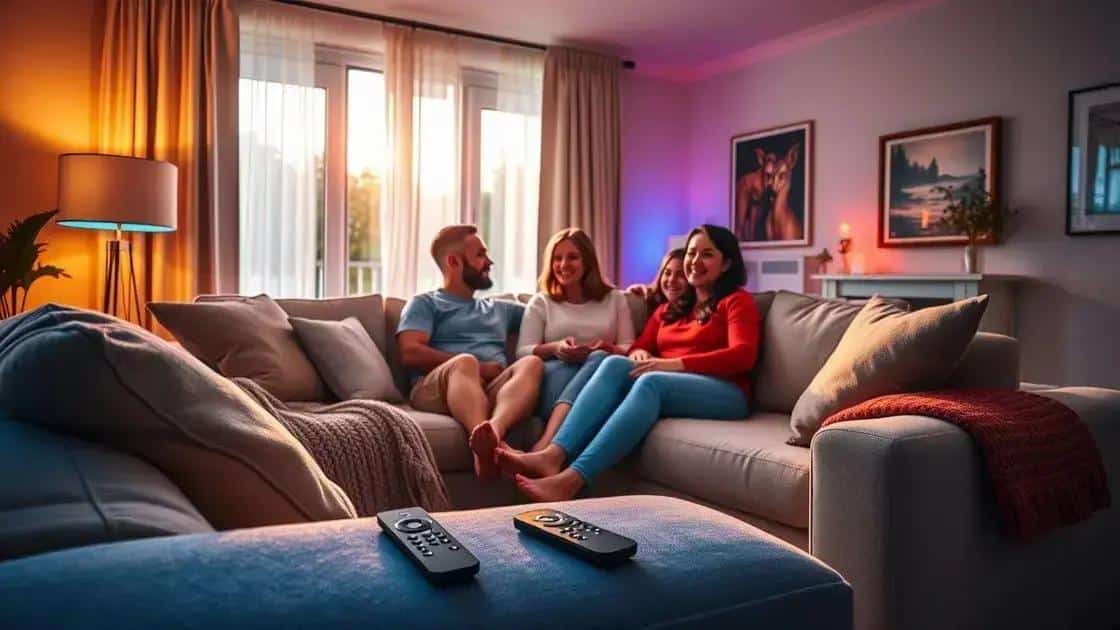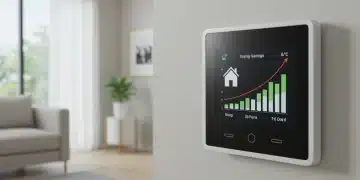Beginner’s guide to smart lighting for your home

A beginner’s guide to smart lighting outlines the benefits, installation steps, and how to choose solutions that enhance convenience, energy efficiency, and home security while offering personalized control over your lighting experience.
When it comes to home automation, a beginner’s guide to smart lighting can be your first step towards a more convenient lifestyle. Imagine controlling your lights with just your voice or smartphone; exciting, right? This guide will help you understand how to bring this innovation into your home.
Understanding smart lighting technology
Understanding smart lighting technology can seem daunting at first, but it’s quite straightforward. Smart lighting consists of lights that can be controlled through smart devices like your phone or voice assistants. These systems offer convenience and energy savings for modern homes.
How Smart Lighting Works
Smart lighting systems use a combination of bulbs, sensors, and wireless communication. When paired with a hub, your lights can communicate with each other and respond to commands. This allows you to turn lights on or off remotely, dim them, or change colors all from your device.
Key Components of Smart Lighting
Here are the essential components of a typical smart lighting system:
- Smart bulbs: These are LED bulbs with built-in connectivity.
- Smart switches: They can replace traditional switches and allow for easy control of all lights.
- Hubs: These connect your smart lights to the internet and your devices.
- Mobile apps: Apps provide a user-friendly interface for control.
The convenience of controlling your lights with just your phone or voice can enhance your daily life. But remember, it’s not just about control; it’s also about creating the right atmosphere. Smart lights can dim during movie nights or brighten in the morning to help you wake up refreshed.
Additionally, smart lighting can increase your home security. You can set your lights to turn on when you are away from home, simulating occupancy. This simple action can deter potential intruders.
Integrating Smart Lighting with Other Systems
Many smart lighting solutions work well with home automation systems, meaning you can synchronize your lighting with your heating or security systems. This integration allows for greater convenience and efficiency.
For instance, you could program your lights to turn on when your security system is disarmed, creating a welcoming environment. Overall, understanding smart lighting technology opens the door to a more connected and intuitive home experience. With the right setup, you can enjoy benefits that enhance both comfort and security.
Benefits of smart lighting in your home

Smart lighting offers numerous benefits that can enhance your living space. By incorporating these advanced lighting systems into your home, you can experience improvements in convenience, safety, and energy efficiency. With smart bulbs and systems, you can control your lights effortlessly, making your everyday tasks easier.
Convenience and Control
One of the most notable benefits of smart lighting is the convenience it provides. Imagine adjusting your lights with just a voice command or through an app on your smartphone. You can easily set schedules for when your lights turn on or off, providing you with greater control over your home environment.
Energy Efficiency
Smart lighting systems are designed to be energy-efficient. By using LED technology, they consume less energy than traditional lighting, leading to reduced electricity bills. You can also monitor your energy usage through mobile applications, making it easier to identify how much energy your lighting consumes.
- Automatic control: Lights can turn off automatically when you leave a room.
- Dimmer options: Adjusting the brightness saves energy.
- Remote access: Control lights from anywhere, ensuring they are off when not needed.
Furthermore, smart lighting can also enhance your home security. By programming your lights to turn on and off during specific times, you can simulate occupancy when you’re away. This added layer of security can deter potential intruders and provide peace of mind.
Another exciting aspect of smart lighting is its ability to create the perfect atmosphere for any occasion. Whether you are hosting a dinner party or enjoying a movie night, you can easily change the lighting to suit your mood. Adjust the colors and brightness with simple voice commands or taps on your device.
Health and Well-being
Smart lighting can also support your health and well-being. By using adaptive lighting that mimics natural light, you can improve your mood and even enhance your sleep quality. Bright lights during the day can help boost productivity, while warmer tones in the evening can prepare your body for rest.
Choosing the right smart lighting solutions
Choosing the right smart lighting solutions for your home is essential to maximize benefits and ensure compatibility with your lifestyle. With so many options available, it can be overwhelming. However, understanding what to look for can make the process smoother.
Consider Your Needs
Before diving into products, think about your specific needs. Do you want to control your lights with your smartphone, or do you prefer voice-activated systems? Consider how you plan to use your lighting. For example, if you often host gatherings, you might prioritize colors and ambiance settings that create an inviting atmosphere.
Types of Smart Lighting Products
There are various types of smart lighting options available. Here are a few categories to consider:
- Smart bulbs: These replace your existing bulbs and connect directly to your home Wi-Fi.
- Smart switches: Ideal for controlling multiple bulbs at once without needing to change them all out.
- Smart fixtures: These come with built-in smart technology and provide a complete solution.
- Smart LED strips: Versatile lighting options for creative spaces and accent lighting.
Selecting the right type depends on your desired functionality, as well as the existing setups in your home. Smart bulbs are great for beginners, while switches offer greater control over groups of lights.
Compatibility and Ecosystem
When choosing smart lighting, ensure that it is compatible with your existing smart home ecosystem. Most systems can work seamlessly with voice assistants like Google Assistant or Amazon Alexa. Check whether the product you are considering is compatible with your chosen platform. This factor can save you from future integration headaches and increase the ease of use.
Another key aspect is to consider the range of connectivity. Some products connect via Wi-Fi, while others might use Zigbee or Z-Wave. Make sure you understand what is needed for your home network to operate smoothly.
Budget Considerations
Smart lighting solutions come in a wide range of prices. It’s essential to set a budget before exploring options. While it can be tempting to go for inexpensive options, remember that quality matters. Cheaper products may lack features or reliability. It’s often better to invest in a few quality smart lighting solutions than to fill your home with lower-quality devices.
In summary, finding the right smart lighting solutions involves assessing your needs, understanding product types, ensuring compatibility, and setting a budget. With the right approach, you can create a tailored smart lighting system that enhances your home experience.
Setting up your smart lighting system

Setting up your smart lighting system is an exciting venture that can greatly enhance your home’s ambiance and convenience. There are a few key steps to follow to ensure a smooth installation and integration into your daily life.
Gather Your Equipment
Before starting the setup, make sure you have all the necessary equipment. This typically includes smart bulbs, smart switches, and a central hub if required. Check the compatibility of your devices with your existing smart home environment. It’s important to have a plan for where you want to place each light and how you will control them.
Installation Steps
The installation process may vary slightly depending on the type of smart lighting solution you choose. Here are general steps to follow:
- Turn off the power: Safety first! Ensure that the power is off at the circuit breaker before you start replacing any bulbs or switches.
- Install smart bulbs: Simply replace your existing bulbs with smart bulbs. Ensure that they are securely fitted.
- Connect smart switches: If using smart switches, remove the existing switch and follow the manufacturer’s instructions for wiring and installation.
- Connect to your hub: If your smart system uses a hub, connect it to your Wi-Fi network and ensure it’s powered on.
After some basic installations, you’ll want to test your lights to ensure they are working correctly. Use the app associated with your smart lighting system to check that everything is responsive and functioning as expected. This is an ideal time to familiarize yourself with the app’s features.
Connecting to Your Network
Once your devices are installed, connect them to your Wi-Fi network. This step is crucial for enabling remote control and integration with voice assistants. Follow the app’s prompts to add each smart bulb or switch into your network. Ensure your smartphone is connected to the same Wi-Fi for seamless setup.
After connection, it’s time to personalize your settings. Most apps will allow you to name each light, group them by room, and set specific schedules. Personalizing your lights enhances usability and allows you to create innovative lighting scenarios tailored to your daily routine.
Testing and Adjustments
After you set everything up, make sure to test each light’s functionality. Use the app to turn lights on and off, adjust brightness, and change colors if available. Take note of any adjustments needed, whether it’s repositioning a light or adjusting your schedules to better fit your lifestyle.
Enjoying your new smart lighting system will enhance your living experience. By following these steps and tailoring your setup, you’ll find that the possibilities are endless.
FAQ – Frequently Asked Questions about Smart Lighting
What is smart lighting?
Smart lighting refers to modern lighting systems that can be controlled remotely via smartphone apps or voice assistants, offering convenience and customization.
How do I install smart lighting?
To install smart lighting, simply replace your existing bulbs with smart bulbs, connect them to your Wi-Fi network, and configure them via the associated app.
Can smart lighting help with energy savings?
Yes, smart lighting systems are energy-efficient and can reduce electricity bills by using less power than traditional lighting.
What are the benefits of using smart lighting?
Smart lighting enhances convenience, improves home security, allows for energy savings, and offers customizable lighting settings for different moods.





